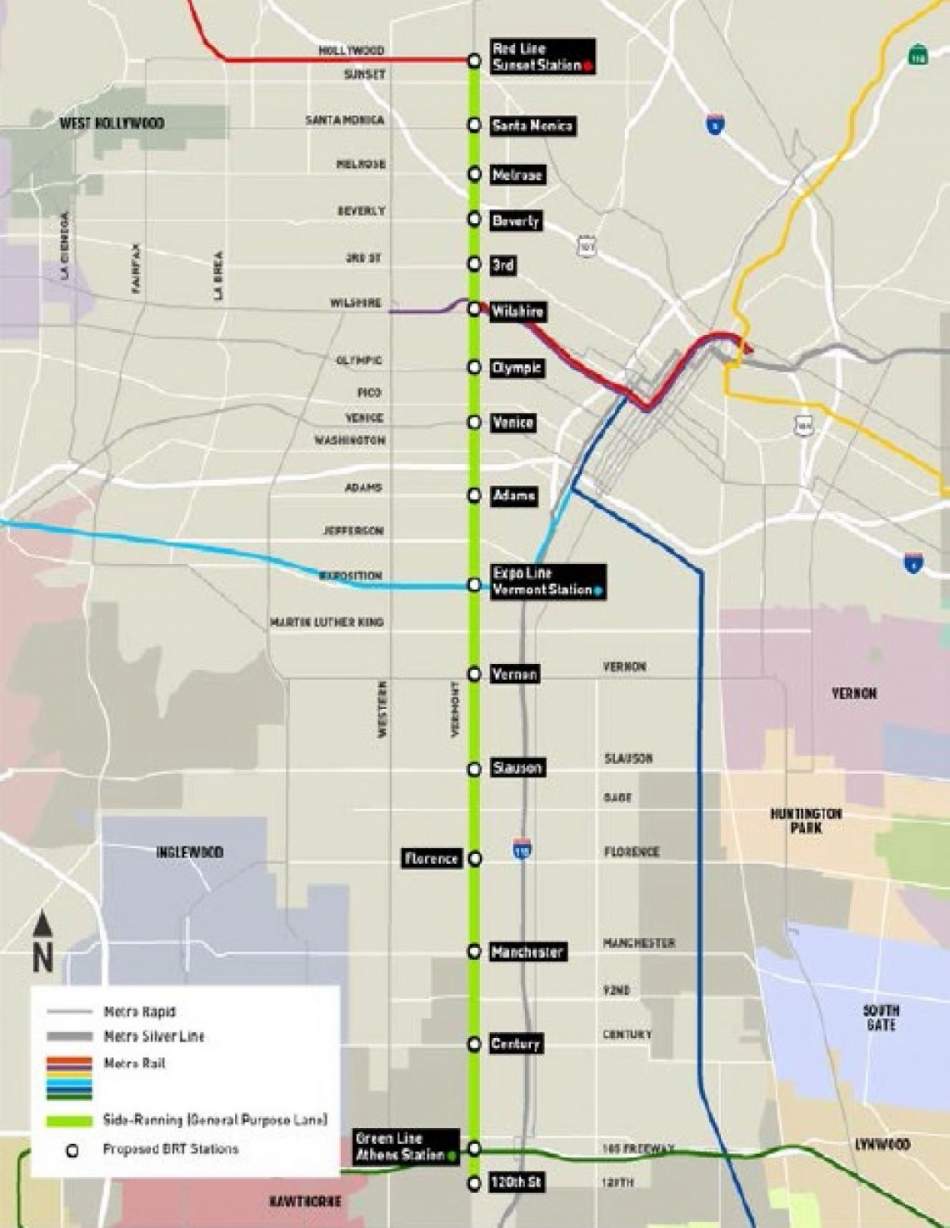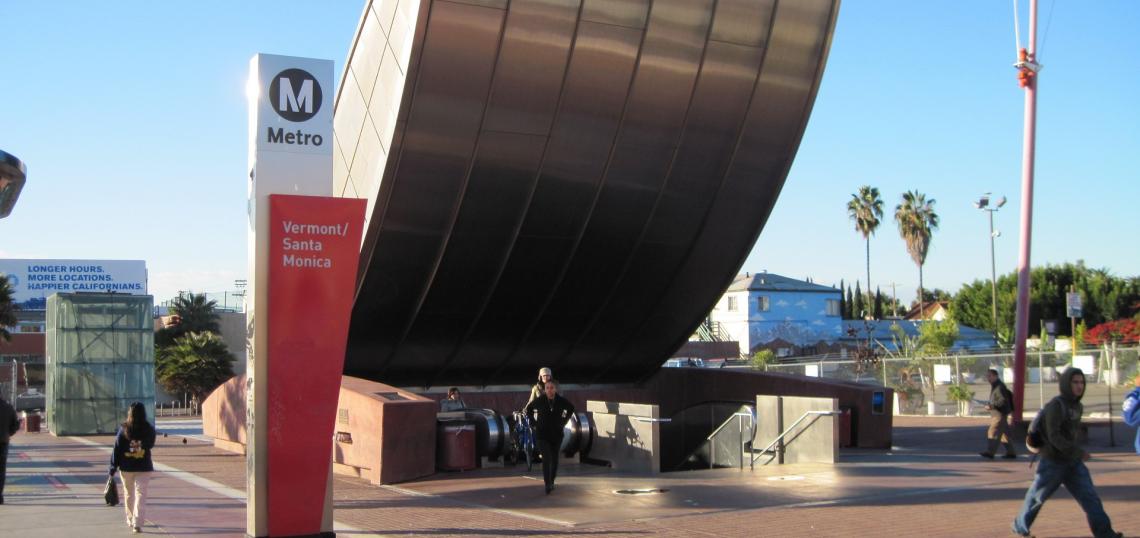Thanks to Measure M and the Olympics, Los Angeles is rapidly building public transit projects, aiming to cast away its international reputation as a city where the only mode of travel is the car. These include extensions to the subway and light rail network as well as several bus rapid transit projects. But one omission is glaring: Vermont Avenue, south of Wilshire Boulevard. While Vermont is the second busiest bus corridor in the region, after Wilshire, the plan is to equip it with BRT, and not rail, even though weaker corridors around the area are slated for rail extensions. Why is this?

The most successful urban rail corridors are the ones built to replace the busiest bus corridors; transportation consultant Jarrett Walker puts it as, “The best case for a rail project is an overcrowded bus line.” This is the logic underlying the Wilshire subway extension. Since Vermont is the second busiest corridor, this by itself suggests that the MTA should seriously consider rail on Vermont, and not BRT.
In fact, both Wilshire and Vermont closely parallel other busy bus corridors which could supply additional ridership. The Purple Line extension is likely to attract riders who are currently stuck in traffic on buses not only on Wilshire, but also on Olympic and Santa Monica Boulevards. By the same token, Vermont is a mile away from Western, the third or fourth busiest bus corridor in the region (Olympic is the other contender for third). It is unlikely that people walk between these routes today, since they are both equally slow buses, both with the same connection to the subway, but if Vermont has a grade-separated heavy rail line, then people will walk.
Even farther away from Vermont, such a subway extension is still likely to be useful. The reason is that if Los Angeles builds a system in which the main east-west spine is Wilshire (paralleled by the slower Expo Line light rail) and the main north-south spines are Vermont and the Blue Line corridor (paralleled by the slower Crenshaw Line), then people who do not live near any of the three lines may well take a connecting bus.
When the Purple Line extension opens in the next decade, many people from beyond walking distance are likely to take a north-south bus - on a route such as Fairfax, La Cienega, or eventually Sepulveda to UCLA - and transfer to the subway. These riders may endure quite a long bus ride, and even though in Metro's statistics they'd be counted as riding a north-south bus widely separated from Vermont and then connecting to the Purple Line, in reality they could ride an east-west line over a shorter distance to Vermont and transfer there.
Without Vermont, riders from farther east still have the Blue Line. But to the west, there are no good corridors: the Crenshaw Line is constructed partly at-grade, and only as far north as the Expo Line—plans for connecting it to Wilshire have not made it to the 28 by 28 list, and would need to involve tunneling anyway. If the MTA needs to tunnel, it should do so under Vermont and not under any of the planned corridors it is considering for Crenshaw, such as La Brea.
Tunnels are not even necessary the entire way. Only the five and a half miles between Wilshire and Gage Avenue need be underground. South of Gage, the street widens considerably to about 180 feet across. On streets so wide, an elevated rapid transit line would not block the sun from the sidewalk, or emit too much noise bothering pedestrians. In researching noise impact, I have recently visited Barbès-Rochechouart, a Paris Metro station elevated over a street only 130 feet wide; from street level, the cars were noisier than the trains. In New York, too, elevated portions of the subway over very wide streets are unobjectionable (for example, in Sunnyside, over the 200 foot wide Queens Boulevard). Elevated lines cost about 50 to 60 percent less than subways according to one database compiled by Bent Flyvbjerg, Nils Bruzelius, and Bert van Wee.
With relatively limited costs thanks to elevated construction, and high potential ridership coming from present-day ridership in the area, Vermont is likely to have limited cost per rider, making it a priority for rail extension. But instead, Metro is proposing BRT.
Unfortunately, BRT alone cannot cut it, not on such a busy corridor. Los Angeles's own history with what happened when it replaced streetcars with buses is one of the primary examples of what transit professionals call a rail bias: passengers are more likely to ride a train than a bus even when service quality (meaning speed and frequency) is the same. In a 1989 paper, Ed Tennyson found that this bias is 34to 43 percent: in other words, keeping speed and frequency equal, a rail service in the US and Canada can expect 34 to 43 percent more riders than a bus.
But the biggest benefit of rail over bus is that it offers higher capacity. The Orange Line offers BRT service every five minutes, with 22,000 riders every weekday, a far cry from the volumes achieved on Wilshire or Vermont; but even then, it is struggling with peak capacity, and cannot run more buses without forcing cars crossing the busway to endure red lights for most of rush hour.
Moreover, without much more infrastructure than Los Angeles has built for BRT, akin to the gold-standard systems in Brazil and Colombia, buses bunch when they are run frequently. The minimum headway between successive buses is about three minutes, and beyond that adding more buses does not really add more capacity. This is why the busiest individual bus routes in North America (including Wilshire) all cluster in the same range - about 50,000 riders per weekday. Light rail lines go higher, since the maximum frequency is about the same or even higher, and the trains are much bigger than buses. On Vermont, already at the cusp of the maximum ridership for a bus line, rail is almost certain to produce higher ridership than an urban bus system could handle.
Because Vermont is such a strong corridor, independent advocates have called for rail investment. Thomas Dorsey runs the African-American travel blog Soul of America, and has produced a plan, coming from proposals made by local activists, for rail investments in the region by 2040—including a rapid transit line on Vermont, running underground between Wilshire and Gage and on an aerial south of Gage. Dorsey does not believe it is as high a priority as some other projects, such as tunneling critical parts of the trunk line carrying both the Blue Line and Expo Line, which run on the surface and are running into problems with capacity. But he does believe that the region should eventually invest in a subway under Vermont, and not just BRT.
Ultimately, it is a question of priorities: coverage, or ridership? If the MTA wants to build something in each region within Los Angeles County, it can keep its current list of projects, with something in the Valley (Orange Line upgrades), something in the Gateway Cities (light rail on the former West Santa Ana Line), something in the San Gabriel Valley (the Foothill extension of the Gold Line), and so on. Most of these lines are unlikely to attract very high ridership, since they serve low-density areas with high car ownership and unwalkable streets.
In contrast, if the goal is ridership, then it's important to increase the priority of lines within the urban core. The Wilshire corridor is already a top priority, but the next priority for the core of the Los Angeles Basin should be Vermont. Alongside other urban rail lines, including the Expo Line, the Gold Line, and the under-construction Crenshaw Line, heavy rail on Vermont would create a densely-connected rapid transit network.
Last decade, Bill Rankin, a Yale professor who studies the history of cartography, produced a map of all urban rail networks in Canada, the United States, and Mexico, at the same scale. The larger cities, including Los Angeles, all have roughly the same reach, with the outer ends located about 10 to 15 miles from city center. The difference is in density in the core: New York and Chicago have more branches connecting their downtown areas with areas 10 to 15 miles out than Los Angeles, and their branches form a larger network within the inner neighborhoods. This is not by itself a substitute for rigorous analysis of costs and benefits, but it suggests that Metro should be focusing on making its urban rail network denser rather than extend it farther out; the proposed end of the Vermont subway, at the 110 for the transfer point to the Green Line, would be nine miles from Wilshire, within that typical range of urban subways.
Los Angeles seems to have overlooked the importance of Vermont Avenue for north-south public transportation. The priority list for the Olympics, and even the Measure M list for midcentury, includes many lines, but not true rapid transit on Vermont, only BRT. As the city is accelerating projects in advance of the Olympics, it should reexamine its priorities; it will most likely find that a subway under Vermont, running on aerial structures south of Gage, has a high benefit-cost ratio and can function as a critical north-south public transit spine in the future.
Alon grew up in Tel Aviv and Singapore. He has blogged at Pedestrian Observations since 2011, covering public transit, urbanism, and development. Now based in Paris, he writes for a variety of publications, including New York YIMBY, Streetsblog, Voice of San Diego, Railway Gazette, the Bay City Beacon, the DC Policy Center, and Urbanize LA. You can find him on Twitter @alon_levy.
- Why the Vermont BRT Line Should be Rail (Urbanize LA)






